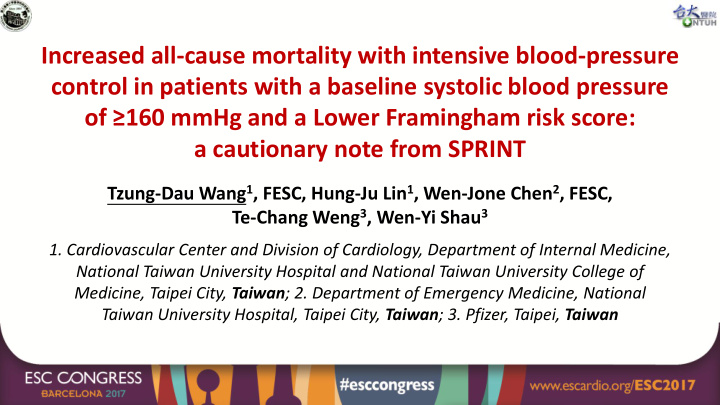



Increased all-cause mortality with intensive blood-pressure control in patients with a baseline systolic blood pressure of ≥ 160 mmHg and a Lower Framingham risk score: a cautionary note from SPRINT Tzung-Dau Wang 1 , FESC, Hung-Ju Lin 1 , Wen-Jone Chen 2 , FESC, Te-Chang Weng 3 , Wen-Yi Shau 3 1. Cardiovascular Center and Division of Cardiology, Department of Internal Medicine, National Taiwan University Hospital and National Taiwan University College of Medicine, Taipei City, Taiwan ; 2. Department of Emergency Medicine, National Taiwan University Hospital, Taipei City, Taiwan ; 3. Pfizer, Taipei, Taiwan
Background SPRINT: Primary outcome J curve: vulnerability to absolute BP value or BP reduction? Universal or individualized BP target? SPRINT: Death from any cause Greater BP reduction, N Engl J Med 2015;373:2103-2116. Chiang CE, Wang TD, et al. Acta Cardiol Sin 2017;33:213-225. smaller risk reduction!?
Purpose and key points about methods Purpose: To examine whether the ideal targets for SBP to reduce all-cause mortality and cardiovascular events vary among persons with different baseline SBP and cardiovascular risks (seeing the devil in the details!). Access to the patient-level data of SPRINT through National Heart, Lung, and Blood Institute BioLINCC data repository after approval from the Institutional Review Board at National Taiwan University Hospital Outcomes: (1) Primary outcome (MI, non-MI ACS, stroke, acute decompensated HF, and CV death), (2) all-cause death, (3) primary outcome + all-cause death, and (4) non-CV death (all-cause death – CV death, including undetermined/not yet adjudicated cases)
Results: Step 4, comparing patients with a baseline systolic BP of ≥160 mmHg and a Framingham 10- yr risk score of ≤31.3% to the rest of SPRINT participants SBP-Framinghan 10-yr risk score combination HR (95% CI)* P int † Intensive Standard no. of patients (%) % per year no. of patients (%) % per year Primary outcome SBP ≥ 160/risk ≤ 31.3% 9/236 (3.8) 1.19 0.95 (0.37-2.46) 0.648 8/244 (3.3) 1.06 All others 310/4447 (7.0) 2.24 0.75 (0.63-0.89) 235/4434 (5.3) 1.68 All-cause death SBP ≥ 160/risk ≤ 31.3% 12/244 (4.9) 1.55 4/236 (1.7) 0.52 3.12 (1.00-9.69) 0.009 All others 206/4447 (4.6) 1.44 0.69 (0.56-0.86) 143/4434 (3.2) 1.00 Primary outcome and all-cause death SBP ≥ 160/risk ≤ 31.3% 11/236 (4.7) 1.45 1.53 (0.71-3.29) 0.075 16/244 (6.6) 2.11 All others 316/4434 (7.1) 2.26 412/4447 (9.3) 2.98 0.76 (0.66-0.88) Non-cardiovascular death SBP ≥ 160/risk ≤ 31.3% 10/244 (4.1) 1.29 4/236 (1.7) 0.52 2.60 (0.81-8.31) 0.036 All others 141/4447 (3.2) 0.99 0.76 (0.59-0.98) 108/4434 (2.4) 0.75 0.1 1.0 10.0 Intensive Better Standard Better *Adjusted for age (treated as quintile) and sex in the subgroup of SBP ≥160 mmHg and 10 - yr risk score of ≤31.3% † Adjusted for age (treated as quintile) and sex and assuming common baseline hazard across clinic
Results: Step 4, comparing patients with a baseline systolic BP of ≥160 mmHg and a Framingham 10- yr risk score of ≤31.3% to the rest of SPRINT participants SPRINT-subgroup: Baseline SBP ≥160 mmHg & SPRINT-original 10- yr Framingham risk score ≤31.3% Death from Any Cause SBP 168 mmHg at baseline SBP 125 mmHg at Year 1 SBP 140 mmHg at Year 1 † Adjusted for age (treated as quintile) and sex, and assuming common baseline hazard across clinic site due to small sample size
Conclusions Among the SPRINT participants with a baseline systolic BP of ≥ 160 mmHg and a lower 10- year Framingham risk score (≤31.3%, median ), targeting a systolic BP of <120 mmHg compared with <140 mmHg resulted in an approximate 3-fold risk of death from any cause Despite of the hypothesis-generating nature, it seems prudent to recommend targeting an SBP of <140 mmHg rather than <120 mmHg in patients with stage 2 hypertension and a 10- year Framingham risk score of ≤30% (close to 31.3 %) There was an intricate interaction between each individual’s baseline blood pressure, their inherent cardiovascular risk, and their degree of blood pressure reduction. We have to consider all three of these elements in managing hypertensive patients
Recommend
More recommend